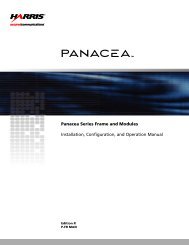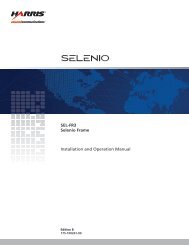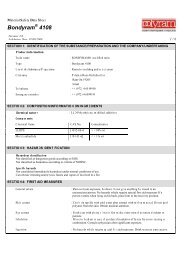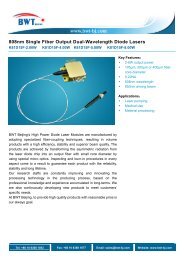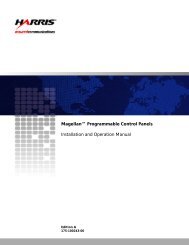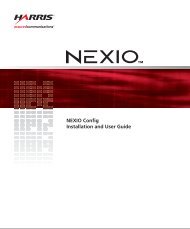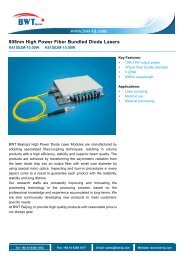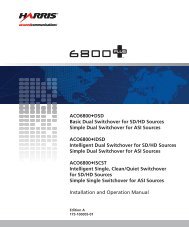T. Chang et al. / Sensors <strong>and</strong> Actuators A 192 (2013) 140– 144 143 Fig. 4. Comparison of (a) nanogap widths <strong>and</strong> (b) detection limits between <strong>the</strong> previously reported nanogap-based sensors (CPE <strong>and</strong> Pd MOTIFE) [14,15] <strong>and</strong> <strong>the</strong> current LNF-processed sensors (sensors A <strong>and</strong> B). The detection limit is found to be substantially lowered in accordance with <strong>the</strong> reduction in <strong>the</strong> nanogaps. having undergone <strong>the</strong> LNF process is that <strong>the</strong> lowest detectable H 2 concentrations, simply termed H 2 detection limits, are 300 <strong>and</strong> 200 ppm for sensors A <strong>and</strong> B, respectively, as shown in <strong>the</strong> insets of Fig. 3. These were drastically reduced from <strong>the</strong> detection limits of previously reported Pd nanogap-based H 2 sensors [14,15]. This result provides a simple means to make more promising H 2 sensors based on Pd nanogaps, as <strong>the</strong> poor detection limit has been one of <strong>the</strong> biggest hurdles to overcome for <strong>the</strong>se sensors to meet high-performance st<strong>and</strong>ards. The comparisons of nanogap widths <strong>and</strong> detection limits between Pd nanogap-based H 2 sensors are summarized in Fig. 4. Representative prior nanogap sensors formed on Pd films, i.e., CPE <strong>and</strong> Pd MOTIFE, exhibited average nanogap widths of 900 <strong>and</strong> 300 nm, respectively, as shown in Fig. 4(a) [14,15]. These large widths led to a relatively high detection limit of 4000 ppm, as shown in Fig. 4(b). Provided that <strong>the</strong> nanogap width is reduced to 90 nm (sensor A), <strong>the</strong> detection limit is drastically reduced to 300 ppm. A fur<strong>the</strong>r decrease in nanogap width to 25 nm (sensor B) results in an even lower detection limit (200 ppm). Although <strong>the</strong> relationship between <strong>the</strong> nanogap width <strong>and</strong> detection limit is not linear, Fig. 4 clearly shows a general dependence of detection limit on nanogap width. The wide nanogaps of <strong>the</strong> previous sensors require high H 2 concentrations (>4000 ppm) to be closed <strong>by</strong> volume expansion of broken Pd films since some amount of phase is required to appear for this physical event. In contrast, <strong>the</strong> much narrower nanogaps of <strong>the</strong> LNF-processed sensors can be closed <strong>by</strong> <strong>the</strong> minimal volume expansion that is triggered <strong>by</strong> H 2 absorption at low concentrations (
144 T. Chang et al. / Sensors <strong>and</strong> Actuators A 192 (2013) 140– 144 process can be easily applied to large-scale thin film processes at low cost, increasing <strong>the</strong> possibility that H 2 sensors based on narrow nanogaps will be commercialized. Acknowledgments This work was supported <strong>by</strong> <strong>the</strong> Priority Research Centers Program through <strong>the</strong> National Research Foundation of Korea (NRF) funded <strong>by</strong> <strong>the</strong> Ministry of Education, Science <strong>and</strong> Technology (2009-0093823) <strong>and</strong> <strong>by</strong> <strong>the</strong> Converging Research Center Program through <strong>the</strong> Ministry of Education, Science, <strong>and</strong> Technology (No. 2010K001430). References [1] D. Porath, A. Bezryadin, S. Vries, C. Dekker, Direct measurement of electrical transport through DNA molecules, Nature 403 (2000) 635–638. [2] C. Chen, F. Ko, C. Chen, T. Liu, E. Chang, Electrical signal amplification of DNA hydridization <strong>by</strong> nanoparticles in a nanoscale gap, Applied Physics Letters 91 (2007) 253103. [3] S. Roy, Z. Gao, Nanostructure-based electrical biosensors, Nano Today 4 (2009) 318–334. [4] M. Spencer, I. Yarovsky, W. Wlodarski, K. Kalantar-zadeh, Interaction of hydrogen with zinc oxide nanorods: why <strong>the</strong> spacing is important, Nanotechnology 22 (2011) 135704. [5] F. Favier, E.C. Walter, M.P. Zach, T. Benter, R.M. Penner, Hydrogen sensors <strong>and</strong> switches from electrodeposited palladium mesowire arrays, Science 293 (2001) 2227–2231. [6] S. Mubeen, B. Yoo, N.V. Myung, Fabrication of nanoelectrodes <strong>and</strong> nanojunction hydrogen sensor, Applied Physics Letters 93 (2008) 133111. [7] F.J. Ibanez, F.P. Zamborini, Reactivity of hydrogen with solid-state films of alkylamine- <strong>and</strong> tetraoctylammonium bromide-stabilized Pd, PdAg, <strong>and</strong> PdAu nanoparticles for sensing <strong>and</strong> catalysis applications, Journal of <strong>the</strong> American Chemical Society 130 (2008) 622–633. [8] E.C. Walter, F. Favier, R.M. Penner, Palladium mesowire arrays for fast hydrogen sensors <strong>and</strong> hydrogen-actuated switches, Analytical Chemistry 74 (2002) 1546–1553. [9] F. Yang, D.K. Taggart, R.M. Penner, Fast, sensitive hydrogen gas detection using single palladium nanowires that resist fracture, Nano Letters 9 (2009) 2177–2182. [10] S. Cherevko, N. Kulyk, J. Fu, C. Chung, Hydrogen sensing performance of electrodeposited conoidal palladium nanowire <strong>and</strong> nanotube arrays, Sensors <strong>and</strong> Actuators B 136 (2009) 388–391. [11] M. Khanuja, S. Kala, B.R. Mehta, F.E. Kruis, Concentration-specific hydrogen sensing behavior in monosized Pd nanoparticle layers, Nanotechnology 20 (2009) 015502. [12] T. Kiefer, L.G. Villanueva, F. Fargier, F. Favier, J. Brugger, Fast <strong>and</strong> robust hydrogen sensors based on discontinuous palladium films on polyimide, fabricated on a wafer scale, Nanotechnology 21 (2010) 505501. [13] M.Z. Atashbar, D. Banerji, S. Singamaneni, Room-temperature hydrogen sensor based on palladium nanowires, IEEE Sensors Journal 5 (2005) 792–797. [14] J. Lee, W. Shim, E. Lee, J. Noh, W. Lee, Highly mobile palladium thin films on an elastomeric substrate, Angew<strong>and</strong>te Chemie International Edition 50 (2011) 5301–5305. [15] J. Lee, J. Noh, S. Lee, B. Song, H. Jung, W. Kim, W. Lee, Cracked palladium films on an elastomeric substrate for use as hydrogensensors, International Journal of Hydrogen Energy 37 (2012) 7934–7939. [16] T. Kiefer, F. Favier, O. Vazquez-Mena, G. Villanueva, J. Brugger, A single nanotrench in a palladium microwire for hydrogen detection, Nanotechnology 19 (2008) 125502. [17] G. Frazier, R. Glosser, Characterization of thin films of <strong>the</strong> palladium–hydrogen system, Journal of <strong>the</strong> Less-Common Metals 74 (1980) 89–96. [18] M.J. Owen, P.J. Smith, Plasma treatment of polydimethyl-siloxane, Journal of Adhesion Science <strong>and</strong> Technology 8 (1994) 1063–1075. [19] D. Fuard, T. Tzvetkova-Chevolleau, S. Decossas, P. Tracqui, P. Schiavone, Optimization of poly-di-methyl-siloxane (PDMS) substrates for studying cellular adhesion <strong>and</strong> motility, Microelectronic Engineering 85 (2008) 1289–1293. [20] J.S. Elizabeth, D.D. Michael, M.W. George, C. Federico, A technique to transfer metallic nanoscale patterns to small <strong>and</strong> non-planar surfaces, ACS Nano 3 (2009) 59–65. [21] W.W. Tooley, S. Feghhi, S.J. Han, J. Wang, N.J. Sniadecki, Thermal fracture of oxidized polydimethylsiloxane during soft lithography of nanopost arrays, Journal of Micromechanics <strong>and</strong> Microengineering 21 (2011) 054013. [22] F.C. Nix, D. MacNair, The <strong>the</strong>rmal expansion of pure metals. Molybdenum, palladium, silver, tantalujm, tungsten, platinum, <strong>and</strong> lead, Physical Review 61 (1942) 74–78. [23] F.A. Lewis, The Palladium Hydrogen System, Academic Press, London, 1967. [24] F.A. Lewis, Hydrogen in palladium <strong>and</strong> palladium alloys, International Journal of Hydrogen Energy 21 (1996) 461–464. [25] E. Lee, J. Lee, J. Koo, W. Lee, T. Lee, Hysteresis behavior of electrical resistance in Pd thin films during <strong>the</strong> process of absorption <strong>and</strong> desorption of hydrogen gas, International Journal of Hydrogen Energy 35 (2010) 6984–6991. Biographies Taehoo Chang was born in 1986 at Incheon, Republic of Korea. He received B.E. in material science <strong>and</strong> engineering at Yonsei University in 2012. He is currently studying on <strong>the</strong> hydrogen sensors based on MOTIFE <strong>and</strong> <strong>the</strong>rmoelectric properties of Bi nanowires toward his M.E. degree at Yonsei University. Hwaebong Jung was born in 1986 at Yesan, Republic of Korea. He received B.E. in material science <strong>and</strong> engineering at Yonsei University in 2012. He is currently studying on <strong>the</strong> MOTIFE sensor <strong>and</strong> hydrogen storage using Mg toward his M.E. degree in hydrogen storage <strong>and</strong> sensor devices at Yonsei University. Byungjin Jang was born in 1987 at Seoul, Republic of Korea. He received B.E. in Material science <strong>and</strong> engineering at Yonsei University in 2012. He is currently studying on <strong>the</strong> MOTIFE sensor using Pd towards his M.E. degree in Hydrogen sensor devices at Yonsei University. Junmin Lee received his M.S. from Materials Science <strong>and</strong> Engineering Department of Yonsei University in 2010. His research interest is to fabricate nanosensors using nanomaterials, etc. He is a doctoral student in <strong>the</strong> Department of Materials Science <strong>and</strong> Engineering at University of Illinois at Urbana-Champaign. Jin-Seo Noh earned his bachelor’s degree in 1991, master’s degree in 1993 from Korea University, Korea, <strong>and</strong> Ph.D. degree in materials science in 2003 from University of Wisconsin–Madison. He has been with <strong>the</strong> Samsung Advanced Institute of Technology (SAIT) as a member of research staff in 2003–2008, where he performed research on next-generation memories <strong>and</strong> logic devices. He spent ano<strong>the</strong>r one year <strong>and</strong> two months working on 28 nm technology development at <strong>the</strong> System LSI Division of Samsung Electronics. In 2009, he was appointed as a research professor to <strong>the</strong> Institute of Nanoscience <strong>and</strong> Nanotechnology of Yonsei University. His current research interests include nanomaterials-based <strong>the</strong>rmoelectric energy conversion, nano electronics/spintronics, nanostructures-utilizing hydrogen gas <strong>and</strong> toxic gas sensors, <strong>and</strong> technology fusion crossing <strong>the</strong> borders. Wooyoung Lee is a professor of Department of Materials Science <strong>and</strong> Engineering, <strong>the</strong> chairman of Yonsei Institute of Convergence Technology <strong>and</strong> <strong>the</strong> Head of Institute of Nanoscience <strong>and</strong> Nanotechnology at Yonsei University in Korea. He received a BS degree in metallurgical engineering in 1986, a MS degree in metallurgical engineering from <strong>the</strong> Yonsei University in 1988. He received a Ph.D. degree in physics from University of Cambridge, Engl<strong>and</strong> in 2000. He is also <strong>the</strong> director in Korea-Israel Industrial R&D Foundation <strong>and</strong> <strong>the</strong> advisor in National Assembly Research Service. In recent years, his research interests have centered on <strong>the</strong>rmoelectric devices, spintronics, hydrogen sensors <strong>and</strong> hydrogen storage materials. He has received a number of awards in nano-related research areas <strong>and</strong> a Service Merit Medal (2008) from <strong>the</strong> Korean Governments due to contribution on <strong>the</strong> development of intellectual properties. He has authored <strong>and</strong> co-authored over 150 publications, <strong>and</strong> has edited a few of special books on nano-structured materials <strong>and</strong> devices.



